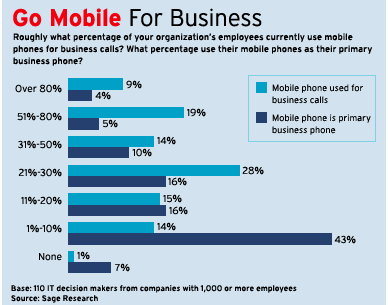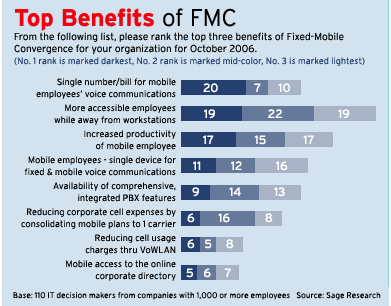VARs Hop On Wi-Fi And Cellular Convergence
With more and more vendors laying groundwork to make the convergence of Wi-Fi and cellular technologies a reality, channel partners said they are getting ready for a communications shift that will drive WLAN, VoIP, applications and services sales.
The seamless hand-off of phone calls between WLANs in offices, homes and public hot spots and the cellular network, also called Fixed-Mobile Convergence (FMC), could be the Holy Grail that provides a strong business case for widespread enterprise wireless deployments, solution providers said.
"It's something that's going to be in high demand. It's going to go through the roof," said Paul Moncrief, regional sales manager at Berbee Information Networks, a Madison, Wis., solution provider acquired earlier this month by CDW.
Aruba Networks this week plans to unveil its road map for bringing FMC to enterprises, while Cisco Systems is prepping its channel to deliver complex multi-application solutions such as FMC with the launch this week of its Master Unified Communications specialization, its new top-level certification for VoIP partners. Cisco also late last month unveiled plans to acquire mobile software vendor Orative, a San Jose, Calif.-based startup whose software will enable Cisco IP communications customers to tie their cell phones into Cisco's VoIP platform.
Other vendors such as Meru Networks, Nortel Networks and Trapeze Networks also are bolstering their portfolios and preparing VARs to capitalize on the emerging FMC market.
The idea that users could replace separate desktop and cellular phones with a single mobile device that provides access to enterprise VoIP calling features and messaging applications is extremely attractive to a wide variety of customers, especially as an increasing amount of business is conducted via mobile phones, solution providers said.
Brent McLeod, director of sales at Adaptive Communications, an Aruba partner in Portsmouth, N.H., said he expects productivity gains from Wi-Fi/cellular convergence to drive sales.
"I'll be able to do four-digit dialing on my cell phone regardless of where I am, and I won't have to dial four different phone numbers to find someone," McLeod said.
In a recent survey by Chadwick Martin Bailey of 110 IT decision makers from companies with 1,000 or more employees, 28 percent of respondents said more than half of their organization's employees use mobile phones for business calls. Nine percent of respondents said more than half of their organization's employees use their mobile phones as their primary business phone.
The FMC paradigm also promises cost-savings for enterprise users who will be able to make some calls for free using VoIP over the corporate WLAN instead of eating up cell phone calling-plan minutes. Solution providers are in a prime position to build FMC solutions for their customers, said Mark Kuta, senior vendor business manager for mobility at Ingram Micro U.S. The Santa Ana, Calif., distributor last week launched a new mobility division to encompass new partnerships with wireless carriers such as Verizon Wireless, Sprint/Nextel and Cingular as well as with device manufacturers and ISVs including Palm, Nokia, Motorola, Research in Motion and Good Technology to help VARs build wireless solutions.

"VARs today are already the trusted source for end users, providing networking and software solutions. When customers understand how mobility comes as an extension of the network, they're going to go to that VAR for help," Kuta said.
To be sure, true FMC isn't quite here, but some of its building blocks are. Dual-mode handsets that have both Wi-Fi and cellular radios, now available from vendors such as i-mate, Motorola, Nokia and Paragon Wireless, are part of a market that's expected to grow. By 2009, the Wi-Fi phone market is expected to hit $3.7 billion, up from $125.5 million in 2005, according to Infonetics Research. The firm projects that 91 percent of Wi-Fi phone revenue will come from dual-mode handsets by 2009, up from 42 percent in 2005.
In addition, products like Cisco's soon-to-be-acquired Orative lineup or Nortel's Dual Mode Mobile Client 3100 are enabling interaction between IP-PBX platforms and cellular phones today. However, hand-offs that would allow a user to receive a call via the cellular network and then continue that conversation as the call moves over to Wi-Fi when the user is in range of the corporate WLAN aren't yet happening.
That scenario will require partnerships between players such as wireless networking and VoIP vendors and wireless service providers, the latter of which will likely need to choose between two competing architecturesUnlicensed Mobile Access (UMA) and IP Multimedia Subsystem (IMS)and possibly invest in new infrastructure to make it happen.
T-Mobile USA is among the first carriers in the United States to roll out dual-mode Wi-Fi/cellular service with the launch late last month of its HotSpot @Home serviceavailable initially only to customers in Seattlewhich allows subscribers to make unlimited calls on their cellular phones via a Wi-Fi network. Other carriers are expected to follow suit.
In the meantime, solution providers today can roll out enterprise WLAN networks that are robust enough to handle latency-sensitive voice traffic, positioning themselves and their customers to take advantage of FMC when it's fully available.
Aruba this week is unveiling several new features for its WLAN platform that aim to improve the performance of voice-over-WLAN deployments, said Keerti Melkote, vice president of product management and marketing at Aruba, Sunnyvale, Calif. The upgrades come as part of Aruba's five-phase architectural road map to bring FMC to enterprise customers, also unveiled this week. "We're not just recreating the cordless phone experience," Melkote said. "The key benefits customers are looking for are data mobility, where you can take IP-PBX services with you, and the ability to have a single number and a single device."

Solution providers will be able to use Aruba's new features, including expanded quality of service, increased call capacity, faster hand-off and extended device battery life, to build networks ready to carry IP voice traffic today and support FMC in the future, he said.
"It's been a long time since I've seen such an opportunity for the channel. It should be on their radar for 2007," Melkote said.
However, Tom Duffy, president of igxglobal, a solution provider in Rock Hill, Conn., questioned whether Aruba has the channel wherewithal to help its partners build such complex solutions. The company, which has partnered with Aruba for about nine months, has been asking for joint planning and strategizing with the vendor on how to tackle opportunities together but has received "only lip service," Duffy said, noting that Aruba had not yet reached out to him to educate him on its FMC strategy.
Melkote said Aruba already has passed through the first phase of its FMC strategy by building voice awareness into its WLAN products. Phase two includes extending the scalability of VoWLAN features, a milestone the company hits with its new features, he said.
Phase three will come with deeper enterprise integration as Aruba develops tighter ties with IP-PBX platforms from partners such as Alcatel and Avaya. The company plans next quarter to launch Mobile Voice Continuity, a software module for its family of mobility controllers that will work with SIP-based IP-PBXes to hand off calls to the cellular network, Duffy said.
Phase four of its road map calls for carrier integration with the Aruba mobility controller taking on the function of a standard security gateway to carriers' UMA architectures, while phase five will provide seamless networking between Wi-Fi and IMS-based cellular networks, he said.
Aruba rivals Meru and Trapeze also are touting the voice-ready features of their WLAN portfolios. Meru, in particular, has positioned itself as a VoWLAN specialist, pointing to quality of service and support for high-density access points as key features to support voice and FMC deployments, said Michael Tennefoss, vice president of marketing at Meru, Sunnyvale, Calif.
"We provide a lot of information about the quality of that voice signal and location information that can be used to determine when is the best time to make the switch from Wi-Fi to cellular," he said.
Trapeze, Pleasanton, Calif., partners with startup DiVitas Networks, Mountain View, Calif., which makes a mobility controller that sits next to an IP-PBX to hand off calls to a 3G wireless network, regardless of the wireless carrier, said John Cladianos, Trapeze's director of technical marketing. Trapeze channel partners are starting to investigate the DiVitas offering to provide FMC solutions now, while broader, mainstream rollouts with participation from wireless service providers are likely 12 to 24 months away, he said.
Solution providers said the technology can't come soon enough. "We're anticipating to be ready for implementation in the near future," said Berbee's Moncrief. "The horizon is shortening very quickly."